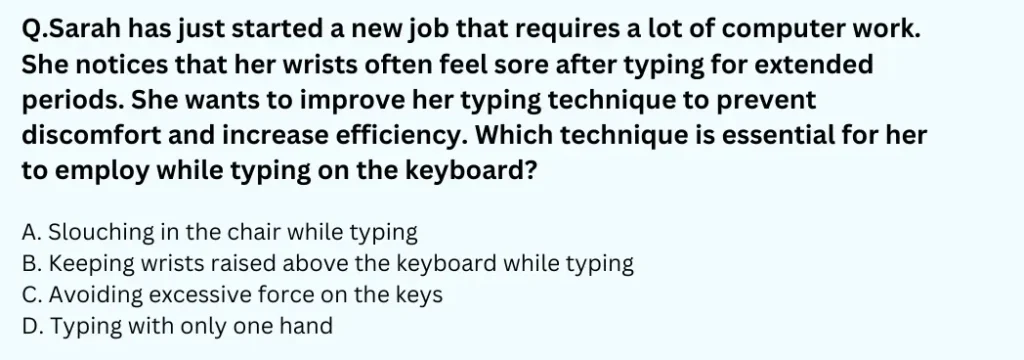Homework Help: Questions and Answers: Sarah has just started a new job that requires a lot of computer work. She notices that her wrists often feel sore after typing for extended periods. She wants to improve her typing technique to prevent discomfort and increase efficiency. Which technique is essential for her to employ while typing on the keyboard?

A. Slouching in the chair while typing
B. Keeping wrists raised above the keyboard while typing
C. Avoiding excessive force on the keys
D. Typing with only one hand
Answer
First, let’s understand the question:
Sarah’s wrists feel sore after typing for extended periods. She wants to improve her typing technique to prevent discomfort and increase efficiency.
Given Option: Step by Step Answering
a) Slouching in the chair while typing:
- Slouching can lead to poor posture, which can contribute to discomfort, including wrist pain. Therefore, this is not an effective technique.
b) Keeping wrists raised above the keyboard while typing:
- Keeping wrists raised above the keyboard can create tension and strain on the wrists, which can lead to discomfort. Proper wrist positioning should be in a neutral, relaxed state, so this is not ideal.
c) Avoiding excessive force on the keys:
- Using excessive force can lead to strain and fatigue, particularly in the fingers, hands, and wrists. Avoiding excessive force reduces the strain and helps prevent discomfort. This is a beneficial technique.
d) Typing with only one hand:
- Typing with only one hand is inefficient and can put extra strain on the wrist of the working hand. This is not a good technique for comfort or efficiency.
Final Answer
Based on the above analysis, the correct answer is:
C. Avoiding excessive force on the keys.
This option is correct answer because it helps reduce strain and prevent discomfort.
Learn More: Homework Help
Q. According to Freud, the hidden messages in your dreams are called:
Q. Which shows the correct order of stages of technological design?
Q. Coworker: “I heard that the computer virus is rather innocuous.”
Q. What does it mean to transcode information from linear to non-linear texts and vice-versa?